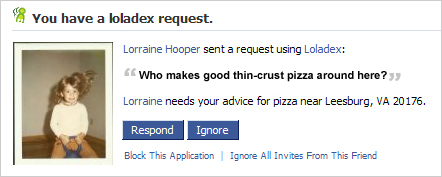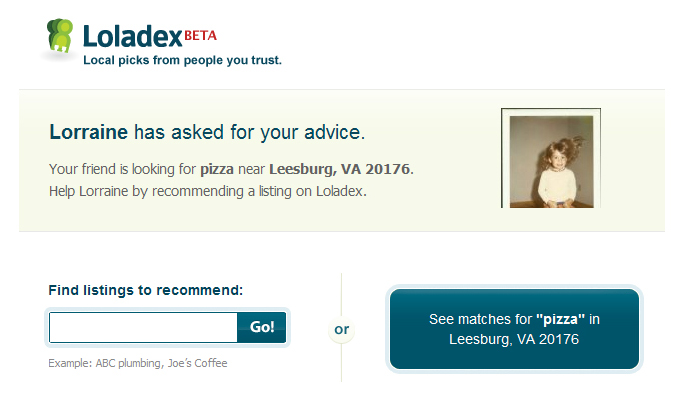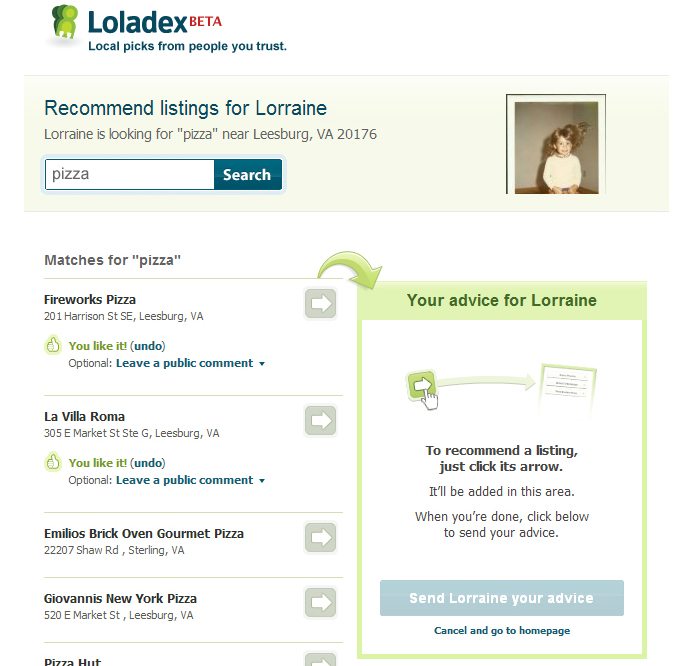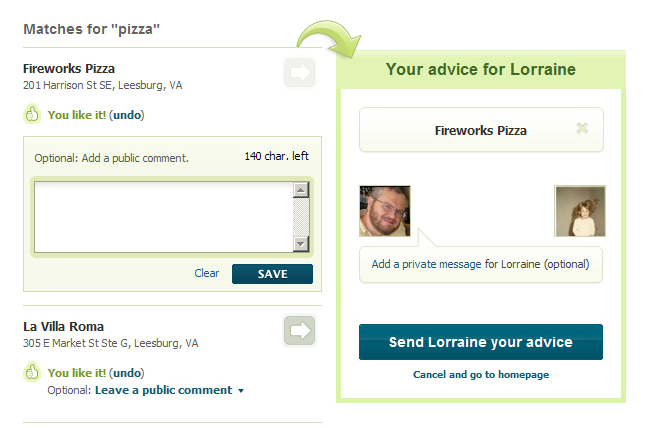
OK, first some background.
People like to ask for recommendations on Facebook. This was becoming evident in 2008; by now it’s entrenched behavior. Mostly people ask via their status. Last month, for instance, my sister asked:
Need recommendations for semi-foodie restaurant in NYC that a chef would like.
She quickly got a bunch of referrals from her friends, including a recommendation for a nice place called Dell’Anima.
Such exchanges happen countless times each day on Facebook (and on Twitter, and elsewhere), and they usually work quite well. But from where I sit, they also leave unfulfilled opportunities.
- First, an opportunity to enrich the current interaction. My sister’s friends made their recommendations via plain old typing, without tags or links, so Facebook didn’t “know” that Dell’Anima is a restaurant. As a result, it didn’t provide a phone number, a star rating, a Web site, reservations on OpenTable, or even just the relevant Facebook page for Dell’Anima. Nor did it provide social context: Some of my sister’s other friends might already have “liked” Dell’Anima elsewhere, which would help her decide.
- Second, an opportunity to enrich future interactions. Unstructured recommendations just float off into the ether after they’re read. If another friend asks the same question tomorrow, the person who recommended Dell’Anima will have to type the same answer all over again. Instead, shouldn’t her recommendation be saved and then displayed to her friends in other contexts, without any work by her?
Facebook has economic reasons to address these needs, and it’s started to do so. It’s trying to add structure by suggesting tags as I type, for example; presumably its suggestions will get better once it can analyze the meaning of my words in real time.
And Facebook still owns everything I’ve done on the service, so maybe I’ll wake up tomorrow and it’ll have extracted, retrospectively, every restaurant recommendation I ever made. Then it could offer to “like” all those places for me.
I’d welcome that, if it worked properly.
Back in 2008, though, recommendations weren’t high on Facebook’s agenda. The plan was — my plan was — that users would share advice via a structured application, not via comments. A “Recommendations” app could ultimately become part of the standard Facebook suite, like Questions is now.
The approach wasn’t crazy then, and it still could be viable today. But it presents a challenge, since using an app will always be harder than typing “Dell’Anima FTW.”
So, back in 2008, here is how we tackled it.
Your friend wants advice: She needs to find a local place that serves good thin-crust pizza. Ideally you see her question in your own news feed, but maybe you get an e-mail or see a Facebook notification (screengrab at top of this post).
Whatever the prompt, we want you to click into the Loladex application. Assuming you’re already a Loladex user (which is a whole other topic), this is what you see next —

(I’m omitting the Facebook stuff that surrounds the app.)
Some good things about the page above: It shows your friend’s name and Facebook photo, which makes this a personal interaction; it recaps the question; it looks nice.
Not so good: It requires an immediate choice between two paths, and we don’t explain the options very well. If we stuck with this approach, better language might have been:
Recommend a business by name, with a button that says “Find“; or
See all matches for “pizza” near Leesburg, VA 20176
Also, it should include the additional info your friend provided: She’s looking for thin-crust pizza.
But actually, we probably should have skipped that landing page entirely and combined it with the next page, which looked like this —

In the listings on the left, anything you’ve previously liked is at the top, since that’s what you’re likely to recommend. (Note: At the time you couldn’t “like” regular businesses on Facebook itself.)
Our aim here was to mimic real-life advice, where people bundle several suggestions and add commentary: “ABC is awesome, but doesn’t do thin-crust. XYZ is a hike, but has excellent thin-crust.”
Hopefully the model is clear: Click the arrow to add each business to your recommendation. After adding a business the page looks like this (just the relevant part shown) —

Anything you write on the right-hand side is between you and your friend. You can delete a business from your recommendation by clicking the “X.”
On the left-hand side, you can add public comments about each place you’ve recommended. Note the 140-character limit on public comments: I’m a believer in such limits, but 140 was just trendiness. 200 would have been better.
I believe that recommending a place also automatically “liked” it, and that you could undo the “like” without undoing the recommendation.
And that’s basically it. Add a note, click to send.
A side question: Should the interaction be private, as shown here, or visible to all friends so they can chime in? In 2011 the instinct is to make it all a quasi-public discussion, but in 2008 we worried about scenarios: Pizza restaurants are fine, but what if you were recommending a doctor and wanted to add a note about your own experience?
In the next post: How users asked for recommendations on Loladex.
